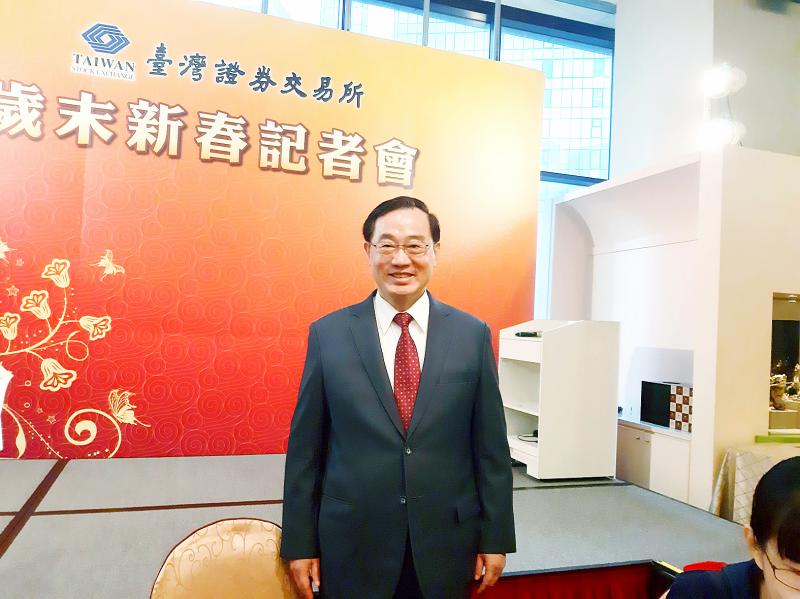The Taiwan Stock Exchange (TWSE), the Taipei Exchange (TPEX), the Taiwan Futures Exchange (TAIFEX) and Taiwan Depository and Clearing Corp (TDCC) could move into one building in downtown Taipei in six years, TWSE chairman Hsu Jan-yau (許璋瑤) said yesterday.
The four companies have invested in an urban renewal project run by Chunghwa Post Co (中華郵政) that would transform the historic Taipei Beimen Post Office site into a national postal museum and two high-rises, Hsu told a news conference in Taipei.
The four are mulling whether to move into one of the high-rises, which could make their coordination efforts more efficient, once construction is completed in six years’ time, he said.

Photo: CNA
TWSE rents office space in Taipei 101, while the other three are headquartered either in Taipei’s Songshan (松山) or Zhongzheng (中正) districts.
The Financial Supervisory Commission, now in New Taipei’s City’s Banciao District (板橋), would probably also relocate to the same building, but it is still in talks with the National Property Administration (NPA), the landowner of the renewal project, he said.
The commission’s plan to have all of its units relocate to the new building has not been finalized, Securities and Futures Bureau Chief Secretary Kao Ching-ping (高晶萍) told the Taipei Times.
Whether the TWSE’s Banciao-based information center, which addresses all online transactions of stocks listed in TWSE and accommodates the TPEX’s and TAIFEX’s computers systems, would also be moved is also uncertain, Kao said.
In related news, the TWSE has set a goal of 24 initial public offering applications this year amid expectations that the economy would improve as the COVID-19 pandemic slows down, Hsu said.
While the TWSE is planning to establish the Taiwan Innovation Board (TIB) for start-ups focused on Internet of Things or artificial intelligence, and biotech firms by July at the earliest, it hopes to see at least five applications, TWSE president Chien Lih-chung (簡立忠) said.
Given that some firms have already approached the exchange to ask about the TIB, it seems that start-ups are interested in the new boards, Chien said.
Meanwhile, Hsu said that odd-lot trading has pushed up the number of shareholders of several high-priced stocks, such as Taiwan Semiconductor Manufacturing Co (台積電) and Largan Precision Co (大立光), since such transactions — referring to orders of fewer than 1,000 — began on Oct. 26 last year.
Thanks to odd-lot trading, the number of brokerage accounts nationwide rose to 616,000 at the end of last year from 218,000 prior to Oct. 26, with the number of investors aged between 21 and 30 more than tripling during that period, TWSE data showed.

TECH BOOST: New TSMC wafer fabs in Arizona are to dramatically improve US advanced chip production, a report by market research firm TrendForce said With Taiwan Semiconductor Manufacturing Co (TSMC, 台積電) pouring large funds into Arizona, the US is expected to see an improvement in its status to become the second-largest maker of advanced semiconductors in 2027, Taipei-based market researcher TrendForce Corp (集邦科技) said in a report last week. TrendForce estimates the US would account for a 21 percent share in the global advanced integrated circuit (IC) production market by 2027, sharply up from the current 9 percent, as TSMC is investing US$65 billion to build three wafer fabs in Arizona, the report said. TrendForce defined the advanced chipmaking processes as the 7-nanometer process or more

China’s Huawei Technologies Co (華為) plans to start mass-producing its most advanced artificial intelligence (AI) chip in the first quarter of next year, even as it struggles to make enough chips due to US restrictions, two people familiar with the matter said. The telecoms conglomerate has sent samples of the Ascend 910C — its newest chip, meant to rival those made by US chipmaker Nvidia Corp — to some technology firms and started taking orders, the sources told Reuters. The 910C is being made by top Chinese contract chipmaker Semiconductor Manufacturing International Corp (SMIC, 中芯) on its N+2 process, but a lack

NVIDIA PLATFORM: Hon Hai’s Mexican facility is to begin production early next year and a Taiwan site is to enter production next month, Nvidia wrote on its blog Hon Hai Precision Industry Co (鴻海精密), the world’s biggest electronics manufacturer, yesterday said it is expanding production capacity of artificial intelligence (AI) servers based on Nvidia Corp’s Blackwell chips in Taiwan, the US and Mexico to cope with rising demand. Hon Hai’s new AI-enabled factories are to use Nvidia’s Omnivores platform to create 3D digital twins to plan and simulate automated production lines at a factory in Hsinchu, the company said in a statement. Nvidia’s Omnivores platform is for developing industrial AI simulation applications and helps bring facilities online faster. Hon Hai’s Mexican facility is to begin production early next year and the

Who would not want a social media audience that grows without new content? During the three years she paused production of her short do-it-yourself (DIY) farmer’s lifestyle videos, Chinese vlogger Li Ziqi (李子柒), 34, has seen her YouTube subscribers increase to 20.2 million from about 14 million. While YouTube is banned in China, her fan base there — although not the size of YouTube’s MrBeast, who has 330 million subscribers — is close to 100 million across the country’s social media platforms Douyin (抖音), Sina Weibo (新浪微博) and Xiaohongshu (小紅書). When Li finally released new videos last week — ending what has